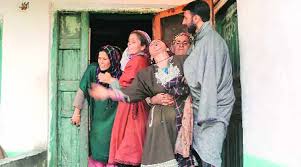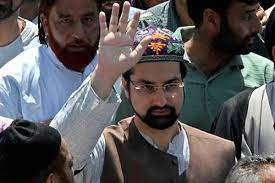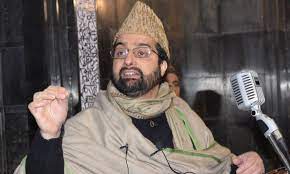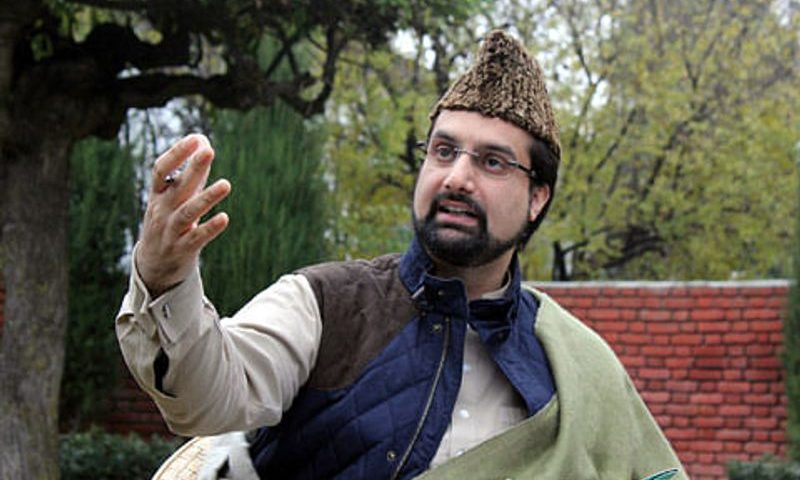Three-year old Burhan Bashir on Saturday became the youngest victim in a fresh cycle of mysterious killings in Kashmir that is now threatening the fragile calm on the ground. Burhan was with his father, Bashir Ahmad when they came under fire from “unidentified gunmen” outside their home at Sagipora in Sopore on Friday evening.
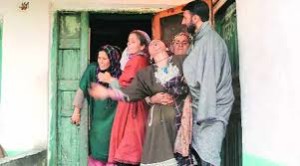 While Bashir, a former Hizbul Mujahideen militant, died instantly, Burhan, in a critical condition after being hit in the abdomen, was rushed to a Srinagar hospital for treatment. He succumbed early Saturday morning and was laid to rest next to his father’s grave. Burhan’s was the third such killing in less than 24 hours, raising questions about the state government’s assertion of “peace returning to the Valley”.
While Bashir, a former Hizbul Mujahideen militant, died instantly, Burhan, in a critical condition after being hit in the abdomen, was rushed to a Srinagar hospital for treatment. He succumbed early Saturday morning and was laid to rest next to his father’s grave. Burhan’s was the third such killing in less than 24 hours, raising questions about the state government’s assertion of “peace returning to the Valley”.
The murder of the toddler has led to widespread outrage in the Valley, with many people turning to social media to vent their anger. Netizens compared Burhan with Aylan Kurdi, the 3-year old Syrian boy, whose picture made headlines after his body was found washed up on a shore in Turkey, as part of Syrian refugee crisis. “Burhan, you are Kashmir’s Aylan Kurdi,” Rouf Ahmad wrote on his Facebook wall, “but there will be no global outrage this time because you are a Kashmiri.”
Bashir’s brother, Ghulam Qadir said that a “group of gun wielding men” had waylaid father and son as they were coming out of the mosque after offering night prayers. “They fired indiscriminately at Bashir, and Burhan – who was accompanying his father – was hit in his belly,” said Qadir. Apparently unaware of his injury and in shock, Burhan had walked home, where his family spotted him bleeding and rushed him to the hospital. Thirty five-year old Bashir is survived by his wife Sakina and 15-month old daughter Hoorain.
According to Qadir and Bashir’s neighbours, the assailants had made several rounds of the locality on a bike without a registration plate. “Sopore is a sensitive area. How could have they have moved around carrying weapons without being spotted by the police or other agencies?” asks Qadir.
Mystery with a history
In a throwback to 1990s, the Valley has witnessed seven killings by unidentified gunmen in the past six days. On September 14, three bullet-riddled bodies were discovered in an orchard in the Pattan area of north Kashmir. The police identified the bodies as those of Ashiq Hussain Wani of Pattan and Muhammad Amir Reshi and Naveed Ahmad Khan from Sopore.
According to his family, 19-year old Reshi had left home two months ago while Wani, a law graduate, and Khan an engineering student, had turned to militancy last year. There were visible marks of torture on the bodies of the three men aged from 19 to 25.
The state police blamed rivalry between Hizbul Mujahideen and a lesser known breakaway group, the Lashkar-e-Islami for the killings, saying the trio belonged to the latter group led by Qayoom Najar – one of the longest surviving and most wanted militants in Kashmir. However, Hizbul Mujahideen chief Syed Sallahuddin has denied this, saying the three were “our active men and were killed in custody.”
A day later, locals discovered the body of 34-year old Manzoor Ahmad Reshi of Tangmarg in north Kashmir near a government school. Reshi’s family alleges he was killed by the Special Operations Group of the police, and has been demanding a probe.
On Saturday, as Burhan’s body was being taken for his last rites, another body, that of Hizbul Mujahideen militant Fayaz Ahmad Bhat, was recovered from paddy fields in the Tangmarg area of Baramulla. Bhat was the fourth active militant to be gunned down in the past one week.
In a statement to a local news agency, the Hizb said Bhat was an active militant for the past six years and was killed by the army in an encounter. However, the police claimed Bhat was killed by the LeI group. “He was not killed in an ambush but in intra-militant group rivalry,” the agency quoted Inspector General of Police (Kashmir) SJM Gilani as saying.
What is Lashkar-e-Islami?
A month later Hizb expelled Najar after an “investigation” by the militant outfit “proved the key role played by Najar in carrying out anti-movement activities”. The four dead militants, according to a senior police official, were caught in the growing feud between Hizb and LeI.The LeI shot into prominence in June this year when attacks by unknown gunmen on telecom towers in Sopore left six persons dead, including former militants and separatist sympathisers. The Najar group was blamed for the attacks, and supposedly declined to halt them despite intervention by Hizb and separatist leaders, leading to a shutdown of telecom services in the Valley.
“We know there are few takers for this reality. Here, people like to make their own assessments about any incident and that is what is happening in these cases too,” the police official said. On cue, the separatists and Hizbul Mujahideen have blamed Indian agencies for the “cold-blooded murders in a bid to create divisions in the ranks and files of jihadis.”
While no clear answers may be forthcoming as to who is behind the killings, rage over young Burhan’s murder has displaced those questions. The state government, which has so far been keeping away from the controversy over the killings, was forced to react this time, with Chief Minister Mufti Muhammad Sayeed on Saturday terming Burhan’s shooting a dastardly act. “My heart goes out to the unfortunate mother of the young child for whom the passing away of hheris son in such inhuman circumstances will be an earth-shattering experience,” Sayeed said.
The National Conference said the killings “at the hands of unknown gunmen are not just terrifying but put a big question mark over the way the government is handling the situation.” “The killing of Burhan is shocking and barbaric,” said the party’s provincial president, Nasir Aslam Wani. “How come bodies are just ‘found’ like that, and no one talks about the killers? The killing of people by design is a dangerous trend, reminiscent of the situation of 1990s,” said Wani, a former minister of state for home.
Hurriyat Conference leader Syed Ali Geelani called for a state-wide shutdown on Sunday to protest the killings of the father-son duo and the militant Fayaz Bhat. Meanwhile, JKLF Chairman Muhammad Yasin Malik announced that he would go on a one-day hunger strike on Tuesday against the killings.
PDP spokesman Waheed Rehman Parra termed the prevailing situation in Kashmir as a “concern” for the government. “It is a concern but we can’t control non-state actors. We have been able to stop the atrocities committed by the state in the past,” Parra said.
‘No bullets fired’ claim backfires
When Chief Minister Sayeed on Friday claimed that during his seven-month tenure, “no bullet was fired by the police or CRPF on stone-pelting youth who hit the streets”, it was instantly taken on by the National Conference. Asking the CM to jog his memory, NC spokesman Junaid Mattoo listed the victims in several recent killings. “Then who killed Suhail Ahmad Sofi of Narbal?” And what about the killing of Bilal Ahmed of Padgampora, Asif Tantray of Kulgam, Khalid Muzaffar of Tral and Farooq Ahmad Bhat of Palhallan?” asked Mattoo.
Suhail was killed when the police opened fire on protestors who were demonstrating against the killing of two youth in army firing in Tral. The incident had forced the government to order an inquiry and eventually arrest two police officials on murder charges.
A sand digger, Bilal was killed when BSF personnel opened fire on people who were protesting against killing of a local militant in Padgampora village of Pulwama district on August 13. The government had ordered a “time bound investigation” into the killing.
Tantray, a 24-year old from Redwani village was shot dead by government forces on June 23 outside his home during an encounter in the area. A salesman, Tantray was hit by a bullet in his throat. In this case too, the government ordered a magisterial inquiry.
Less than two months after the PDP-BJP government took over in J&K, the Army killed Khalid Muzaffar, the brother of Kashmir’s most wanted militant, Burhan Wani of the Hizbul Mujahideen, on April 13 in Kamla forest of Tral in South Kashmir’s Pulwama. Khalid and his three friends, according to the villagers, had gone to the forests to meet Burhan, and was picked by the army after a brief shootout and later killed in custody. However, this is denied by the Army, which claims that Khalid, who was pursuing a post graduate degree in economics, was a “listed over ground worker” for the Hizb and had taken his three friends to the forest to get them recruited into the militant organisation.
The “no bullet fired” remark has evoked sharp criticism from separatist leaders too. “The killings by state forces continue and there is no end to the atrocities being committed on people,” Geelani had said in his statement. He also castigated the government for continuing to use pellet guns in street confrontations with protestors, saying dozens of youth had been disabled by them during the past seven months.
Information accessed under an RTI application by Manan Bukhari, member of the Mirwaiz Umar Farooq led Hurriyat, revealed that 67 cases of pellet injuries were reported in different hospitals after the PDP-led government took over the reins in J&K. “At least 12 victims have suffered serious injuries in their eye(s) due to the pellets fired by the state forces,” the RTI response says. What angers critics more is that the fact that the PDP, when in opposition, had vehemently protested the use of pellet guns for quelling street protests, but has continued to allow their use after the party came to power in the state.
Commenting on the prevailing situation, political scientist at Kashmir University, Gul Wani said the Valley was “sinking deeper and deeper into chaos, hopelessness and sense of rejection.”

